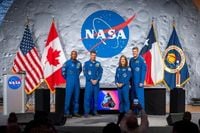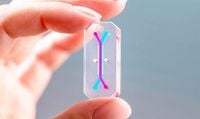NASA is gearing up for a historic journey that will see four astronauts loop around the Moon before splashing down off the coast of San Diego—a mission that not only marks humanity’s return to lunar proximity but also launches a new era in space medicine. The Artemis II mission, scheduled for liftoff as early as February 5, 2026 (with a backup window extending to April 26), will be the first crewed voyage to the Moon since Apollo 17 in 1972, according to Times of San Diego.
Onboard the Orion capsule, perched atop the formidable Space Launch System rocket at Cape Canaveral, will be NASA astronauts Reid Wiseman, Victor Glover, and Christina Koch, joined by Canadian Space Agency astronaut Jeremy Hansen. Their mission: a 10-day, looping journey around the Moon, culminating in a splashdown in the Pacific Ocean off San Diego. The recovery? A Navy amphibious warship, a nod to both tradition and the evolving logistics of space exploration. The Navy, which successfully recovered the uncrewed Artemis I capsule in 2022 and has since honed its retrieval skills off San Diego, stands ready for this next chapter. Notably, SpaceX has also begun recovering its own crewed capsules in the Pacific, just off Oceanside, signaling a growing West Coast role in spaceflight recovery.
But Artemis II is about more than just the thrill of human exploration. NASA is using this mission as a proving ground for a revolutionary experiment called AVATAR, which aims to decode how deep space affects human biology. As Earth.com reports, AVATAR will send tiny, living lab devices—organ chips made from the astronauts’ own cells—inside Orion for the duration of the mission. These chips, about the size of a thumb drive, are designed to mimic the function of specific human tissues such as bone marrow, heart, lung, liver, and brain. Their goal: to provide vital insights into how the extreme conditions of deep space—especially cosmic radiation and microgravity—impact the human body.
"AVATAR is NASA’s visionary tissue chip experiment that will revolutionize the very way we will do science, medicine, and human multi-planetary exploration," said Nicky Fox, associate administrator for NASA’s Science Mission Directorate, as quoted by Earth.com. Each tissue chip is a personalized model, crafted using blood-forming stem and progenitor cells donated by the Artemis II astronauts themselves. By comparing how these cells behave in deep space versus on Earth, NASA hopes to eliminate guesswork and build a clear picture of the risks and changes astronauts face.
Bone marrow is the first focus for AVATAR, and for good reason. It’s the cradle of our red and white blood cells, as well as platelets—essential for immunity, oxygen transport, and healing. It also happens to be one of the most sensitive tissues when it comes to radiation exposure. Research already shows that microgravity can reshape bone structure and alter the marrow’s environment, potentially impacting crew health on long missions. The AVATAR chips will let NASA observe these effects in real time, using the actual astronauts’ cells. This is a game changer: it means that, for the first time, scientists can see exactly how each crew member’s biology responds to the stresses of space.
Earth’s magnetosphere shields us from much of the Sun’s and galaxy’s charged particles. But once Orion ventures beyond that protective bubble, the crew and their cells are exposed to much higher levels of cosmic radiation. Data from Artemis I showed that radiation dose rates can vary widely depending on spacecraft shielding and orientation. Now, with AVATAR, NASA will get a direct readout of how human cells respond to these doses, turning raw radiation numbers into meaningful medical information.
The chips will travel inside a self-contained payload—built by Space Tango—that maintains temperature and feeds the cells on a precise schedule. This automated system means that the astronauts can focus on piloting and safety, rather than tending to the experiment. After the Orion capsule splashes down and is recovered by the Navy, scientists will analyze the chips using single-cell RNA sequencing. This advanced technique measures gene activity across thousands of genes in each cell, providing a detailed map of how spaceflight changes biology at a cellular level.
Lisa Carnell, director of NASA’s Biological and Physical Sciences division, emphasized the importance of this work: "For NASA, organ chips could provide vital data for protecting astronaut health on deep space missions." If the AVATAR experiment reveals unique vulnerabilities in a particular astronaut’s cells, future missions could be equipped with tailored medical kits and countermeasures, rather than relying on a generic, one-size-fits-all pharmacy. This personalized approach is not only more efficient, but it could also make the difference between life and death on missions lasting weeks or months, far from any earthly clinic.
The potential impact of AVATAR extends beyond the Artemis program. The same organ chip technology is already being used on Earth to predict how people respond to drugs or radiation, and to speed up the development of new cancer therapies. By linking multiple chips together, scientists can study how different organs interact—a crucial step in understanding complex side effects or unexpected changes that only emerge when systems are combined. Faster, more human-relevant screening could reduce the need for animal testing and help doctors personalize treatments for patients who respond differently to the same medication.
AVATAR’s initial 10-day run is just the beginning. NASA envisions longer chip cultures on future missions, allowing scientists to study slower, more subtle changes over weeks or months—the kind of timescales relevant for Mars expeditions. As the library of biological responses grows, patterns will emerge, revealing both shared risks and individual differences. If a particular pathway in bone marrow proves especially vulnerable, NASA can test countermeasures on the ground before validating them in space. The approach could eventually expand to other tissues, including the heart, lung, brain, and liver, building a comprehensive roadmap for astronaut health.
All of this is happening as Artemis II sets the stage for Artemis III, currently slated for 2027. That mission aims to land astronauts on the Moon for the first time in more than half a century—a leap that will demand even greater understanding of how space travel affects the human body. As NASA blends cutting-edge biology with bold exploration, the lessons learned from Artemis II’s chips could ripple far beyond the Moon, shaping the future of medicine both in space and here on Earth.
The countdown is on, and with it, a new era of science, medicine, and human adventure. As the world watches Artemis II, the mission’s legacy may well be written not just in miles traveled, but in the secrets unlocked within each tiny chip—a testament to how far curiosity and innovation can take us.






